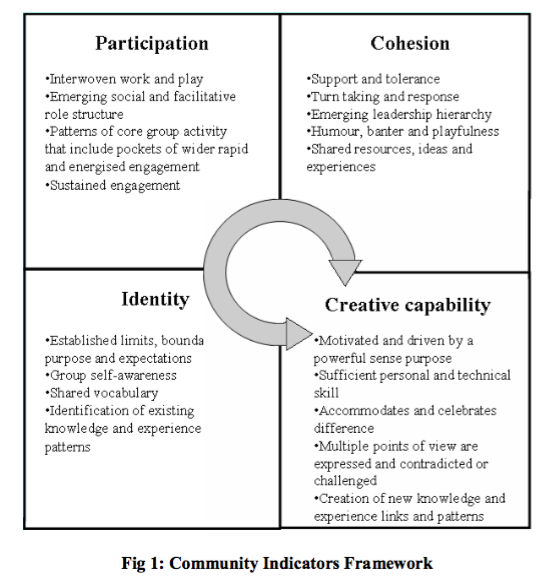
CIF
I am now reading about another framework that supports online community activity by Alevizou, Conole and Galley (2012). The community indicators are Participation, Cohesion, Identity and Creative Capability. There is some overlap with another research paper I read and blogged about recently about the key elements of an educational experience – Cognitive presence, Social presence and Teacher presence (Garrison, Anderson and Archer, 2000).
Community Indicators: a framework for observing and supporting community activity on Cloudworks (Alevizou, Conole and Galley, 2012) is a rather snazzy form of action research whereby the quality of an online community experience (Cloudworks) is improved by applying current research and literature recommendations in real-time. An organic experiment if you will, this research puts forward a framework that supports “productive communities in space” (p1). Dubbed Design-Based-Reasarch – an iterative process that combines researchers and educators in real-world settings, this very much reminds me of the iterative process involved with learning design approach.
Cloudworks
Cloudworks supports: peer-critiquing, sharing, user-generated content, aggregation and personalisation
Cloudworks promotes: creative and reflective professional practice and development
Being a big fan of Open University I was curious to learn about Cloudworks – a professional social network for education professionals. I really like what it represents “encouraging more innovative learning design by getting teachers to openly share, discuss and develop design ideas” (p2) As I mentioned above, this is similar to the Teachers As Designers concept, an online professional development course I co-moderated last year. The central tenet being to provide the framework for teachers to develop their own ideas and share their learnings with others, in real time. Thumbs up from me!
CoP vs CIF
From this reading I understand better that Communities of Practice (CoP) are more traditional, closed, and bounded environments, perhaps more often seen in f2f settings. Whereas Community of Inquiry (CoI) “could be described as innovative, creative and explorative” (p7). But I suppose that both can be useful depending on context. During my Masters course we used our own private Forum Discussion area on Moodle to share ideas with our tutor and classmates. We asked questions of each other and shared knowledge. We took turns leading and contributing to brief discussions. Our objectives were clear – to support each other through our respective modules. And there was a lot of social interaction in between the academic debates to facilitate that. But at the same time, we brought in information from external sources like twitter feeds, online professional development forums and education blogs. I would say that in the form of module assignments we were given the opportunity to transform our new knowledge into creative products – like wikis, blogs and online presentations. Perhaps, then, my course is a good example of a combined CoP/CoI. Both open and closed. Sometimes traditional, sometimes not. Both which validate the ‘Learning in online communities’ framework my tutors designed our Masters course on…
…OK let’s pause on the CoP/CoI concept for now. Will reflect more on how that combo may lead to the creation of innovative and creative products, and the four indicators themselves, in my next post!
Reference
Galley, R., G.Conole, P. Alevizou, (2014). Community indicators: a framework for observing and supporting community activity on Cloudworks. Interactive Learning Environments, 22(3) pp.373-395.
